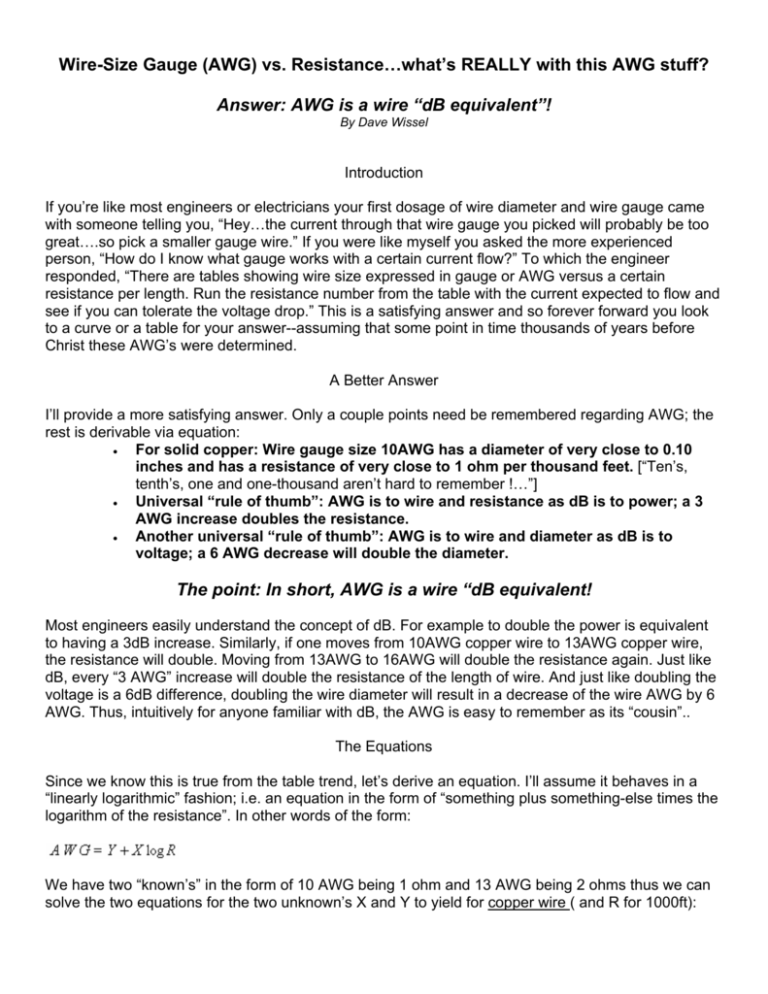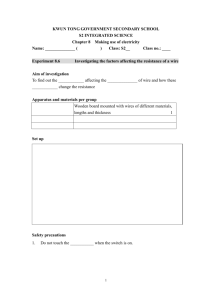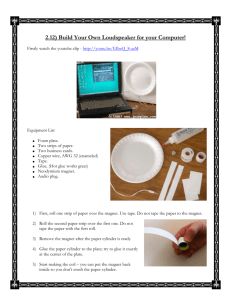Wire-Size Gauge (AWG)
advertisement

Wire-Size Gauge (AWG) vs. Resistance…what’s REALLY with this AWG stuff? Answer: AWG is a wire “dB equivalent”! By Dave Wissel Introduction If you’re like most engineers or electricians your first dosage of wire diameter and wire gauge came with someone telling you, “Hey…the current through that wire gauge you picked will probably be too great….so pick a smaller gauge wire.” If you were like myself you asked the more experienced person, “How do I know what gauge works with a certain current flow?” To which the engineer responded, “There are tables showing wire size expressed in gauge or AWG versus a certain resistance per length. Run the resistance number from the table with the current expected to flow and see if you can tolerate the voltage drop.” This is a satisfying answer and so forever forward you look to a curve or a table for your answer--assuming that some point in time thousands of years before Christ these AWG’s were determined. A Better Answer I’ll provide a more satisfying answer. Only a couple points need be remembered regarding AWG; the rest is derivable via equation: • For solid copper: Wire gauge size 10AWG has a diameter of very close to 0.10 inches and has a resistance of very close to 1 ohm per thousand feet. [“Ten’s, tenth’s, one and one-thousand aren’t hard to remember !…”] • Universal “rule of thumb”: AWG is to wire and resistance as dB is to power; a 3 AWG increase doubles the resistance. • Another universal “rule of thumb”: AWG is to wire and diameter as dB is to voltage; a 6 AWG decrease will double the diameter. The point: In short, AWG is a wire “dB equivalent! Most engineers easily understand the concept of dB. For example to double the power is equivalent to having a 3dB increase. Similarly, if one moves from 10AWG copper wire to 13AWG copper wire, the resistance will double. Moving from 13AWG to 16AWG will double the resistance again. Just like dB, every “3 AWG” increase will double the resistance of the length of wire. And just like doubling the voltage is a 6dB difference, doubling the wire diameter will result in a decrease of the wire AWG by 6 AWG. Thus, intuitively for anyone familiar with dB, the AWG is easy to remember as its “cousin”.. The Equations Since we know this is true from the table trend, let’s derive an equation. I’ll assume it behaves in a “linearly logarithmic” fashion; i.e. an equation in the form of “something plus something-else times the logarithm of the resistance”. In other words of the form: We have two “known’s” in the form of 10 AWG being 1 ohm and 13 AWG being 2 ohms thus we can solve the two equations for the two unknown’s X and Y to yield for copper wire ( and R for 1000ft): You can swap this around to yield a convenient form for resistance in terms of AWG for copper wire as: For purists from a few charts the resistance of 10 AWG copper wire is listed as 0.9989 ohms per thousand feet. Using this factor, the equation for the “pocket-protector” people would be slightly different. But to me memorizing 0.9989 is a lot harder than remembering its close-enough cousin, “one”. By the way, if you are dealing with Aluminum wire the “1 ohm gauge” is approximately 8 AWG aluminum wire. Thus a 10 AWG copper wire has roughly the same resistance as an 8 AWG Aluminum wire. Thus changing the gauge of the Aluminum wire by going from 8AWG to 11 AWG will multiply the resistance of the wire by two. For Aluminum wire the approximate equation is: For purists and some tables of AL wire the “8” in the above equation is closer to 7.87…but it is more educational to see trends and not digits in my opinion. And to determine the resistance from the AWG for aluminum wire it is simply and approximately: What about Diameter vs AWG? Intuitively to go from voltage to power involves an equation proportional to the square of voltage. For power we have a 10log “power ratio” and seeing the square term yields a 20 log “voltage ratio”. Thus, since resistance is inversely proportional to area, and, diameter-squared is proportional to area, one would expect an equation for AWG in terms of diameter to have a 20 log factor. Knowing the “6dB trend” and knowing that the diameter of 10 AWG copper wire is 0.102—or for our purposes of “closeenough” this is 0.1 inches--we can use a similar approach to determine the AWG number of copper wire from its approximate diameter in inches: To approximately “go the other way” is simple for copper wire: Some other helpful links: http://wiki.xtronics.com/index.php/Wire-Gauge_Ampacity http://en.wikipedia.org/wiki/American_wire_gauge






